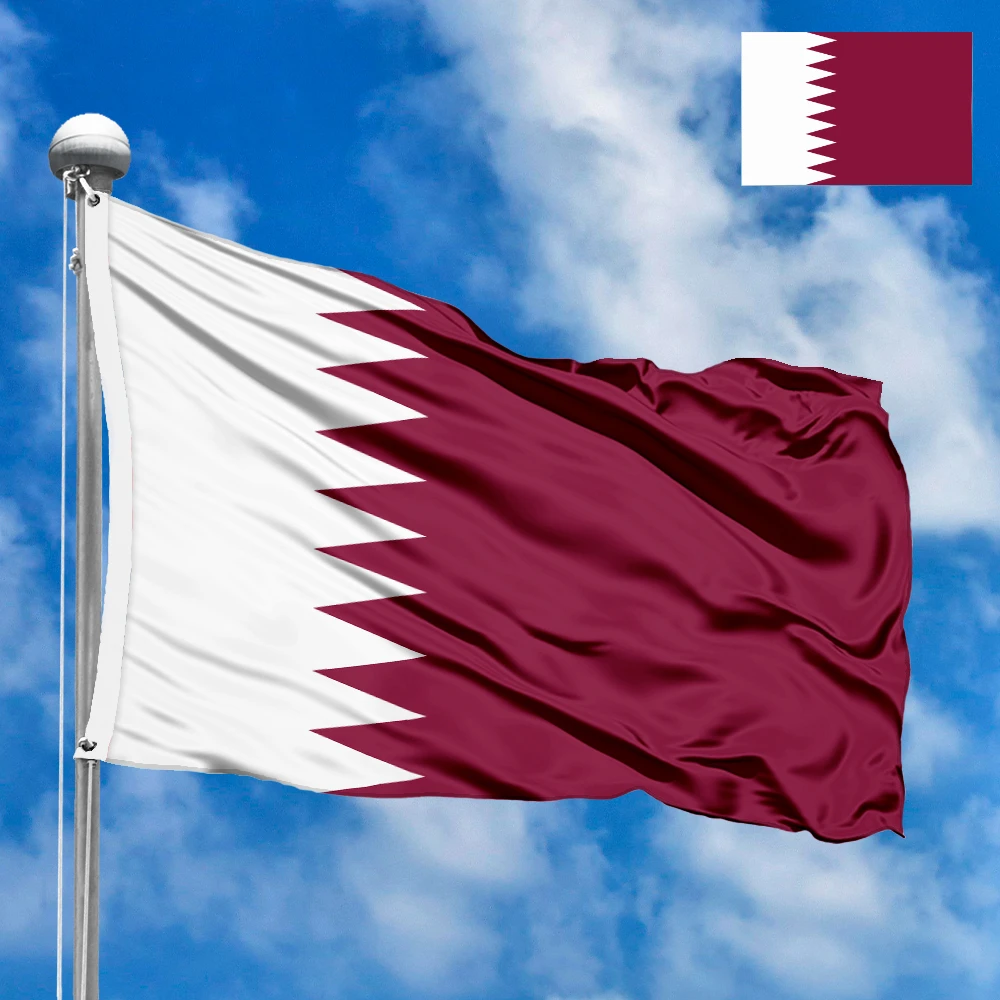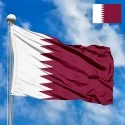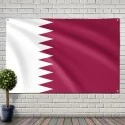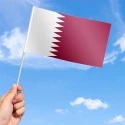The national flag of Qatar is a striking and instantly recognizable emblem, deeply rooted in the nation's history, culture, and geographical identity. Adopted in its current form in 1971, the year Qatar declared its full independence from British protection, it stands as a powerful symbol of sovereignty, resilience, and the unique heritage of the Qatari people in the Arabian Gulf.
Design and Dimensions
The flag of Qatar features a distinctive design characterized by its maroon field and a white serrated band on the hoist (left) side. This serrated band consists of nine white triangles that create a unique zigzag edge separating it from the maroon field. The official proportions of the Qatari flag are typically 11:28 (height to width), making it unusually elongated compared to many other national flags. This specific ratio, along with its unique color and serrated edge, makes the Qatari flag one of the most identifiable in the world.
Symbolism of the Colors and Elements
Every element and color on the Qatari flag is imbued with profound symbolic meaning, reflecting key aspects of the nation's identity and historical journey:
-
Maroon Field: The dominant maroon color (often described as purplish-red or dark red) is a unique and highly significant feature of the Qatari flag. It symbolizes the blood shed during the many wars and conflicts that Qatar has endured throughout its history, particularly in the 19th century. This color also traditionally represents the historical and cultural connection to the Gulf region and the specific reddish-purple dye that was historically produced in the area from murex shells, giving the flag a unique local tint. It embodies the resilience and unwavering spirit of the Qatari people.
-
White Band: The white band on the hoist side of the flag symbolizes peace. It represents Qatar's commitment to peace, both internally among its diverse population and externally in its relations with other nations. White is a universal color associated with purity, honesty, and tranquility, signifying the nation's aspirations for a stable and harmonious future.
-
Nine Serrated Points: The nine white triangles forming the serrated (saw-toothed) edge between the white and maroon fields are perhaps the most historically significant and distinctive element. These nine points represent Qatar's historical position as the 9th member of the "reconciled emirates" of the Persian Gulf at the conclusion of the Qatari-British treaty in 1916. At that time, eight other emirates (which would later form the United Arab Emirates) had already signed similar protection treaties with Britain. The nine points thus signify Qatar's distinct identity and its historical entry into the regional political framework under British protection. They also symbolize the strong, unwavering bonds between the state and its people, creating a protective barrier.
History of Creation and Adoption
The history of the Qatari flag is closely tied to the region's complex political landscape and its relationship with the British Empire. Prior to the early 20th century, flags in the Arabian Gulf were often simple red banners, a common color in Islamic and Arab flags. However, as British influence grew, a need arose to differentiate the flags of various sheikhdoms.
In the mid-19th century, under the rule of Sheikh Mohammed bin Thani, a plain red flag began to be modified. To distinguish it from neighboring states, particularly Bahrain (which used a white and red flag with fewer points), Qatar's flag evolved. Initially, the red was a brighter crimson. However, exposure to sunlight caused the red dye to fade to a purplish-red or maroon color, which gradually became the distinctive and preferred shade, embracing this unique hue.
The serrated edge, with its specific number of points, was standardized over time. The nine points officially represented Qatar's status as the ninth emirate to sign a protection treaty with Britain. This design was formally established in 1932 by a British proclamation, which also specified the unique proportions.
The flag as we know it today was officially confirmed upon Qatar's full independence on September 3, 1971. On this momentous day, the "Al-Adaam" (the nickname for the Qatari flag, meaning "the Support" or "the Mainstay") was raised, marking the birth of a fully sovereign state. Its continuity in design from its earlier forms underscored a strong link to historical identity while embracing a new era of self-governance.
Significance for the Inhabitants
For the people of Qatar, their national flag is a profound symbol of national pride, independence, and a rich historical legacy. It embodies the nation's journey from a pearl-diving and trading hub to a modern, globally influential state built on vast natural gas reserves. The maroon color evokes a sense of sacrifice and resilience, reminding citizens of the struggles and battles fought for their sovereignty and way of life.
The flag represents the unity of the Qatari people and their allegiance to the ruling Al Thani family. It's a visible representation of their unique identity among Gulf Arab states, particularly due to its distinctive color and serrated design. Displayed prominently on national holidays, government buildings, and during international events, the flag serves as a constant reminder of Qatar's strong cultural roots, its commitment to peace, and its aspirations for continued prosperity and influence on the world stage. It's a source of collective identity and a symbol of the nation's remarkable transformation.
Interesting Facts
-
Unique Color: Qatar's flag is the only national flag in the world that is predominantly maroon. This unique color is a result of the natural fading of the traditional red dye used in the region, which evolved into a preferred, distinctive shade.
-
Unusual Proportions: At 11:28, the Qatari flag has one of the most elongated ratios of any national flag, making it visually distinct. This ratio is thought to be derived from the standard flag size used by the British Royal Navy at the time of its design.
-
"Al-Adaam" Nickname: The flag is affectionately known as "Al-Adaam" by Qataris, which translates to "the Support" or "the Mainstay," highlighting its importance as a symbol of national strength and stability.
-
Historical Link to Bahrain: The serrated design and color scheme of the Qatari flag are historically linked to the flag of Bahrain, which also uses red and white with a serrated edge. The key differences (number of points, shade of red, and proportion) distinguish the two.
-
Originally Red: Before the 1930s, the flag was predominantly bright red. The maroon color developed due to the sun's effect on the dyes, and this faded color became so characteristic that it was officially adopted.
-
Nine Points Significance: The nine points are a direct historical reference to Qatar's formal inclusion as the ninth signatory to the British-Gulf treaties, emphasizing its individual status among the Gulf sheikhdoms.
-
Strict Display Rules: There are strict regulations in Qatar regarding the proper display and handling of the national flag, reflecting the deep reverence and respect it commands from the population.
In the demonstration images, full-size flags are shown with proportions of 2:3, and hand-held flags with proportions of 1:2.






 Waving flag
Waving flag
 Sizes:
Sizes:
 Round flag
Round flag
 Sizes:
Sizes:
 Rectangular flag 2:3
Rectangular flag 2:3
 Sizes:
Sizes: